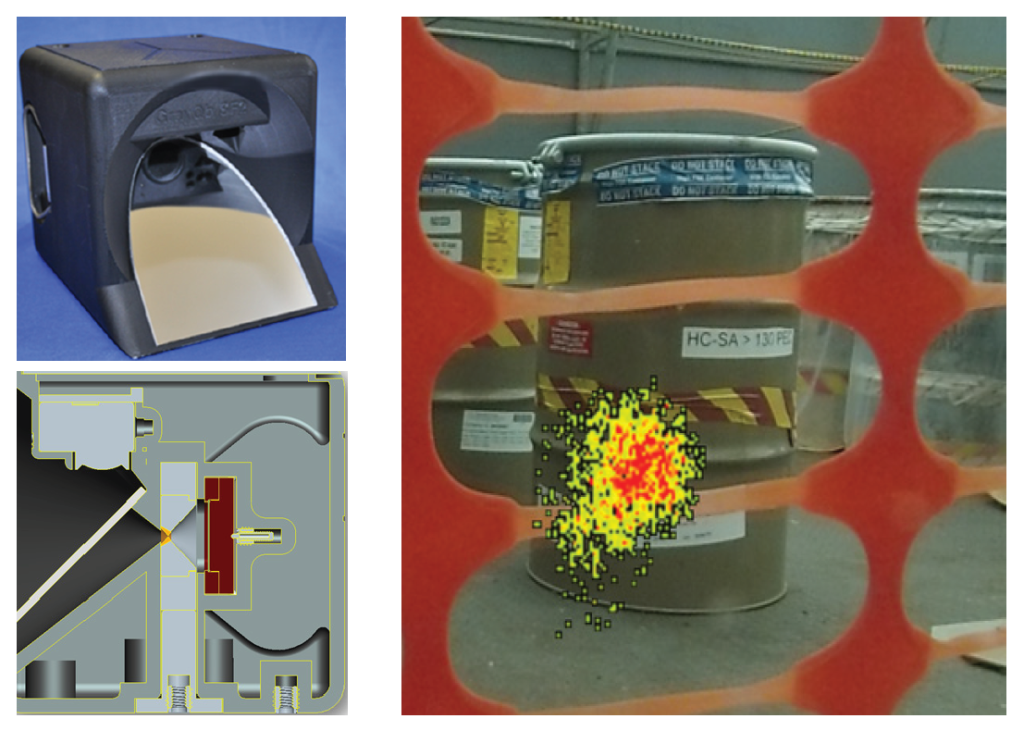Tech Briefs
Savannah River National Laboratory
GrayQb: A Radiological Contamination Locating and Mapping Tool
Technology Overview
Savannah River National Laboratory developed an innovative camera system to show radiation sources in an easy to use and interpret package. GrayQb (pronounced “gray cube”) produces a 2D color image with an overlay of radiation intensity, akin to a weather map showing storm intensity. A 3D version is also available that can help pinpoint the exact location of material, for instance on the surface or inside of a container.

(left) GrayQb device and cross section of GrayQb. (right) GrayQb image on drums showing one of them contains some nuclear material.
Benefits
- Easy to operate
- Self-contained unit for imag-ing – no special power, cool-ing or handling requirements
- Standard color camera, easy to use gamma camera and reader
- Software automatically processes images, sliders to adjust intensity display
- Lightweight – less than 5 lbs. without additional background shielding
- Easy to interpret
- Location and relative intensity of radiation is shown in a well-known format similar to a weather map showing storm intensity
- Color image of background makes location of nuclear material easy to interpret
- Robust design
- Entire camera system is in a 6” cube
- Strong design is tolerant of abusive handling
- Tested in a wide temperature range (-21°F to 100°F)
Applications and Industries
- Nuclear cleanup
- Medical imaging safety evaluations
- Emergency response to a dirty bomb
Description
GrayQb is designed to be used by relatively untrained technicians in an operational environment. GrayQb cannot provide exact dose rates or isotopic composition. It is designed for use as an initial screening tool to identify hot spots for further analysis and as an operational tool during cleanup to clearly highlight areas of concern and to audit the cleanup process.
GrayQb utilizes two coaxial cameras. A plastic mirror reflects visible light to an optical camera while gamma radiation passes through the mirror and to a tungsten pin hole camera where the image is captured on a Phosphor Storage Plate (PSP). PSPs are commonly used for dental x-rays and are reusable for hundreds of images. Exposure time depends on dose rate and can vary from minutes to hours. After exposure, the PSP is read by a commercially available reader that also resets the PSP to take a new reading. Using SRNL developed software, the PSP image is combined with the color photograph to produce an image reminiscent of a weather map showing storm intensity.
Intellectual Property
- US 9,291,719 Radiation Imaging System
- US 9,377,536 Radiation Imaging System
- US 10,935,677 Image Plate Calibration System
- CA 2,968,842 A Radiation Imaging System
GrayQb has completed development and has been used in field deployments in the US and abroad.
Partnering opportunities
SRNL invites interested companies with proven capabilities in this area of expertise to develop commercial applications for this process under a cooperative research and development agreement (CRADA) or licensing agreement. Interested companies will be requested to submit a business plan setting forth company qualifications, strategies, activities, and milestones for commercializing this invention. Qualifications should include past experience at bringing similar products to market, reason-able schedule for product launch, sufficient manufacturing capacity, established distribution networks, and evidence of sufficient financial resources for product development and launch.
Download Tech Brief
Contact Information
Savannah River National Laboratory
E-mail: SRNL-Partnerships@srnl.doe.gov